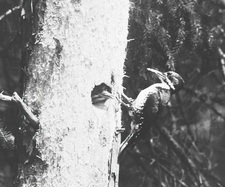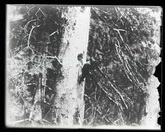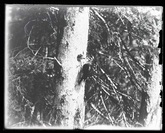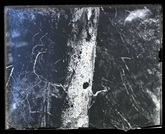In yesterday’s Tuesday Tweet, I shared an image from a glass plate negative of a Black-backed Woodpecker from June of 1902. The images were from a series of negatives Thomas Sadler Roberts produced on his collecting trip to Lake Itasca that summer. As soon as I posted the images, it occurred to me that Roberts would have likely kept a journal or bird observation list for this collecting trip. I searched the finding aid for the Bell Museum records, and sure enough, Box 5 listed a folder titled “T.S. Roberts. Itasca Park bird lists, 1902.”
I retrieved Box 5, opened the applicable folder, and found Roberts’s journal along with partially typed transcriptions. The envelopes that enclose the negatives of the Black-backed Woodpecker contain notations that include the date June 22, 1902. Sure enough, the notebook had an entry on June 22 that contained a description of the Black-backed Woodpecker, also known as the Arctic or Three-Toed Woodpecker. Roberts wrote:
Arctic Three-Toed Woodpecker [Black-backed Woodpecker]
1902 – Lake Itasca
6/22. Spent time from 9 a.m. at nest taking series of photographs. Nesting hole in live jack pine 12 feet from ground. Hole facing south toward open tree only 20 feet from road and open field and close by a log house occupied as a store. On edge of a tamarack spruce swamp. Outer bark chipped off tree for a distance of 12 – 15 inches above and below hole and halfway around tree thus leaving a large irregular white area. Tree about 7 inches in diameter at nest. Male and female fed young about alike, returning 6 – 8 times in an hour, not always alternately. The male was much more wary about coming to nest and usually spent several minutes flying from tree, “crucking” and “cricking” and making false attempts before finally getting up sufficient courage. Often he approached from the opposite side of the tree. The female usually went direct. They seemed to bring but a single large white grub or larva each time and remained but an instant at the hole, the young birds coming to the opening to be fed. The young kept up a constant twittering and crying even when the old birds were nowhere around. Always after feeding the old birds repaired to a neighboring dead stump or dead limb to drum a moment before going for more food.
The usual note of the old birds was a sharp short “cruck” sometimes “crick” sometimes several of these notes rapidly uttered. At other time a typical woodpecker rattling cry. When the sexes met at the hole they would sometimes utter, with tail spread and wings partially spread and quivering, a low rattling series of notes.
Sometimes when the male was hesitating about returning to the hole the direct return of the female would seem to inspire the needed courage and he would immediately follow her and join her, seeming to think that if it was all right for her it would be safe for him to try it.”



